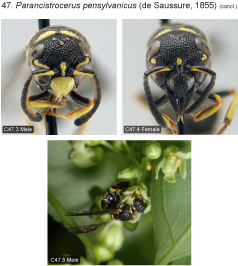
| Home | Table of contents | Keys | Species list | Glossary | Image data | PDF | Cite this article | Feedback | Updates |
Identification Atlas of the Vespidae (Hymenoptera, Aculeata) of the northeastern Nearctic region
CJAI 05, February 19, 2008
doi: 10.3752/cjai.2008.05
Matthias Buck, Stephen A. Marshall, and David K.B. Cheung
Department of Environmental Biology, University of Guelph, Guelph, Ontario, Canada N1G 2W1
Next species | Previous species | Key
47. Parancistrocerus pensylvanicus (de Saussure, 1855)
Figs B2.9; B7.36, 38, 40, 44, 46, 56; C47.1–5.

|

|
Taxonomic note. We are not convinced that the ivory colour form, which was described as ssp. ignotatus (Bohart, 1952) (see below) merits formal recognition.
Species recognition. Similar to P. pedestris with which it often occurs together in Carolinian parts of Ontario (differences discussed under that species). The pale colour form is also very similar to the rare Stenodynerus lucidus. The male of that species differs from P. pensylvanicus by the small flagellomere XI (i.e., not extending to base of F X), the dark flagellum (yellowish ventrally in P. pensylvanicus), and the absence of an anteroventral depression near base of mid femur. Both sexes of S. lucidus lack apical fasciae on segments 3 and onward.
Variation. Fore wing length 5.0–6.5 mm (♂♂), 5.0–7.0 mm (♀♀). Thickening of apical margin of tergum 2 variable, its thickness 0.3–1.0x mid ocellar diameter (male) or 0.2–0.5x mid ocellar diameter (female). Pale markings of body bright yellow to ivory. The pale yellow form is the predominant form in central and northern Ontario. Ivory specimens are very rare in the east and have only been found in the northernmost part of the range. The ivory form is more common in the west and was described as ssp. ignotatus (see below). Female clypeus usually black, in bright yellow specimens often with a pair of yellow dorsal spots; male clypeus in aberrant specimens sometimes with an irregular black discal mark. Interantennal spot restricted to area above interantennal prominence in female, sometimes extending almost to clypeus in male. Transverse pronotal band usually narrow, sometimes interrupted or subinterrupted laterally, in pale females often abbreviated laterally. Parategula marked with yellow, or occasionally with obscure brownish; parategula in small, dark specimens sometimes completely black. Female terga 1–(4)5 and male terga 1–5 or 6 with apical fasciae, fascia of tergum 3 usually absent, interrupted or reduced to lateral spots, very rarely complete. Discal spots of tergum 2 sometimes present in female (these specimens are difficult to separate from P. pedestris); also present in one exceptional male. Sternum 2 with apical fascia, in female often, in male rarely interrupted, sides of sternum 3 rarely with apical spots.
Distribution. Transcontinental in Canada and the northern U.S., south to NC, MO, TX, NM, CO and OR (Krombein 1979). The ivory-marked ssp. ignotatus has been recorded from NB and the northern and western U.S. (MI, MN, ID, WA to CA), and is recorded here for the first time from Ontario.
Biology. Nests in borings in twigs. Prey are caterpillars of Tortricidae (Krombein 1979).
Next species | Previous species | Key
| Home | Table of contents | Keys | Species list | Glossary | Image data | PDF | Cite this article | Feedback | Updates |
